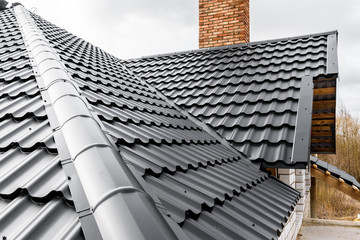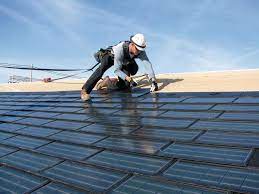Your roof plays a critical role in protecting your home. It shields you from the elements, offers insulation, and enhances your property’s value. However, it is not indestructible. Damage can occur due to severe weather conditions that call for immediate emergency repairs.
Almost all situations like this require professional help from a trusted emergency roofer. However, homeowners can take a few proactive steps to mitigate damages until professionals arrive. Check out https://www.lakewood-roofing.com/ to learn more.
Storm Damage
 Severe storms can cause serious damage to a home’s structure, especially its roof. High winds, heavy rains, hail, and falling debris can lead to leak penetrations, structural damage, and other hazards that call for emergency roof repair. The sooner a homeowner takes corrective measures, the more they can minimize long-term damage.
Severe storms can cause serious damage to a home’s structure, especially its roof. High winds, heavy rains, hail, and falling debris can lead to leak penetrations, structural damage, and other hazards that call for emergency roof repair. The sooner a homeowner takes corrective measures, the more they can minimize long-term damage.
Initially, it’s crucial to assess whether or not a roofing emergency exists. If the roof is in danger of collapsing, you should evacuate immediately and wait for professional assistance. Once the weather clears, you can safely inspect for damage and determine if an urgent roof repair is needed.
You should start by checking for active leaks and visible stains on the ceiling. You can also check for sagging roof sections, which are indicative of compromised structural support. Additionally, it’s a good idea to take a look at your gutter system and ensure that it is free of leaves and other debris.
If you notice any signs of damage, make sure to take photos and notes. These can help you document the extent of the damage and provide evidence for your insurance claim, if necessary. Once you’ve assessed the situation, you can take preventive measures to limit water intrusion until a professional can arrive.
A quick and effective solution is to cover the affected area with a tarp. This will keep out rain and other elements until a roofing contractor can arrive. Additionally, you can place buckets underneath any leaky areas to catch the water and mitigate further damage.
Lastly, you can use spray foam to seal small leaks. This is an easy and cheap solution for a short-term fix, but it’s not suitable for large areas or long-term repairs.
If you’re in need of emergency roof repair, it’s essential to choose a reputable roofing contractor. Make sure to ask for references and read online reviews to gauge a company’s reliability. It’s also a good idea to check for credentials like certification from the National Roofing Contractors Association and similar organizations. This indicates that the roofing contractor adheres to industry standards and best practices.
Water Intrusion
Emergency roof repair can be a stressful experience for homeowners. The key to minimizing damage is acting quickly and knowing what to do when a problem arises.
One of the biggest concerns for homeowners is water intrusion, which can lead to severe property damage and mold growth. Even a small leak can cause major problems in a short amount of time. Moisture intrusion can also damage insulation, lead to rot in wood and other materials, and exacerbate existing structural issues.
The best way to prevent moisture intrusion is through regular inspections and proper maintenance. Professionals can catch minor issues before they escalate and can help identify areas that need to be repaired or replaced. Investing in a quality roofing system made of durable materials can also ensure your home stays protected against extreme weather conditions.
During a storm, it’s important to stay indoors and away from any areas that may be unstable or have visible signs of damage. If you must go outside, wear a safety harness and use a ladder that’s secure. Always avoid climbing on a damaged or weakened roof to prevent falling and serious injuries.
If you spot a leak during a heavy rainstorm, call a roofer for immediate assistance. Look for a company that offers 24/7 emergency roof repairs and is licensed and insured to ensure high-quality work. Also, beware of unqualified roofers who may appear after a storm to offer cheap or quick fixes.
Many homeowners are not aware that certain types of damage can be covered by their insurance policies. Sudden damage from severe weather is more likely to be covered than damage caused by neglect or wear and tear. However, it’s still important to talk to your insurer about the specifics of your policy.
Emergency roof repair can be an expensive undertaking, but it’s a necessary investment to protect your home and family from costly structural damage. By following these tips and practicing regular roof maintenance, you can minimize the risk of an unexpected roofing crisis and save money in the long run. If you’re experiencing a roof leak or other roofing issue, contact a qualified roofer today for a free estimate.
Safety Hazards
Extreme weather conditions can cause sudden damage to roofs, leading to emergency situations that require prompt attention. Managing these situations wisely can help homeowners avoid long-term damage and minimize the cost of professional repairs.
First and foremost, safety is an important consideration when handling roofing emergencies. If the damage to your roof poses a risk to your personal wellbeing, do not attempt to address it yourself, especially in hazardous weather. If you must take action to protect your property, the following steps are essential.
Identifying the Source of the Emergency
The most common cause of emergency roof repair is water intrusion. This can result in ruined furniture, electronics, and other valuables within the home. It can also encourage the growth of mold and mildew, which is a health hazard for occupants. It is also possible that the water may cause structural damage to support beams, putting the entire building at risk of collapse.
If you notice signs of leaks, such as water stains on ceilings or walls, it is time to call in the professionals. A professional will be able to find the source of the leak and implement a durable solution, preventing further damage to your home and belongings.
Depending on the type of roof, it may be possible to temporarily patch leaks with a bit of tar or roof cement. These are available at most hardware stores, and they should be applied generously to cover the affected area and ensure a strong seal. In addition, you can use spray foam to make a quick repair on small leaks and holes, as it expands and hardens, providing a temporary seal.
Loose shingles can also lead to urgent roof repair needs, and these can be quickly fixed with roofing cement or nails. This can prevent further damage from wind and rain, and it will allow you to buy some time until a professional can arrive.
Often, the best way to assess roof damage is from inside the house. This will allow you to see the extent of the damage, and it will give you a better idea of what to expect when professional roofing experts arrive. In addition, assessing the situation from inside the house can also help you prioritize tasks and determine what is most urgently needed.
Damage Containment
The roof is one of the most vulnerable parts of a home, particularly following severe storms. High winds, rain, hail, and fallen debris can wreak havoc, causing sudden leaks and structural threats. The key to minimizing damage is prompt action.
Emergency roofing repair helps contain water intrusion and prevent further harm. It also limits risks, reduces business interruptions, and cuts long-term repair costs. Regular inspections are a good way to identify potential problem areas. Performing basic emergency repairs is another effective strategy for safeguarding your investment and preventing costly damages.
Aim for quick, low-cost solutions in a roof emergency to limit damage and avoid long-term consequences. For instance, a roof leak near electrical wiring poses a serious fire risk. This is because the leaking water may come into contact with the electrical wires, triggering short circuits and sparking. If the leaking area is close to electrical components, turn off the power and call in a professional to resolve the issue as soon as possible.
In a roof emergency, you can use buckets or towels to catch dripping water and protect interior surfaces. Alternatively, you can cover the affected area with a durable tarp to block ingress and direct water away from your property. Tarps are easy to obtain from most hardware stores, and you can find options that are compatible with your roofing system for a seamless finish.
During an emergency roof repair, you can also remove dead or decayed tree limbs and other debris to ensure proper drainage. Additionally, you should clear leaves and debris from the gutters to prevent clogging. If the roof shingles or underlayment have been damaged by fire, it is important to have them replaced immediately. This can help limit long-term damage to the structure and minimize the risk of further loss of value for your home.
If you are experiencing extensive damage and are in need of emergency roofing services, you should contact a trusted roofing company like Five Guys Roofing right away. Their experienced technicians can assess your roof for any damage and provide comprehensive services to restore its integrity.

